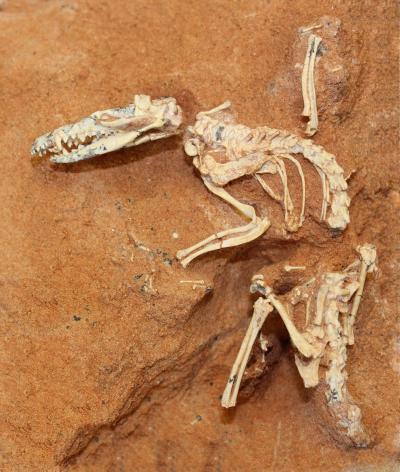Want to feel small? Humans have been included in the most comprehensive tree of life to-date on placental mammals. And placental mammals are the largest branch of the mammalian family tree, with more than 5,100 living species.
The ancestor of all placental mammals was a tiny, furry-tailed creature that evolved shortly after the dinosaurs disappeared. The paper in Science details how researchers used both genetic and physical traits to reconstruct the common ancestor of placental mammals, the creature that gave rise to many mammals alive today. They show that, contrary to a commonly held theory, the group diversified after the extinction of dinosaurs 65 million years ago. Basically, dinosaurs had to die so we could live.
The team analyzed the anatomy of living and fossil primates, including lemurs, monkeys and humans, as well as their closest living relatives, flying lemurs and tree shrews. It was an extensive interdisciplinary effort that utilized molecular (DNA) and morphological (anatomy) data on an extraordinary scale.

This shrew-sized Cretaceous-age animal, Ukhaatherium nessovi, which was uncovered in 1994 in the Gobi Desert by the Mongolian Academy and the American Museum of Natural History, is one of the many mammals used in the recent mammal tree-of-life study. When it was discovered, the remarkably well-preserved skeleton of this small creature showed the presence of epipubic bones, attached to both sides of the pubis. In living mammals, these bones occur only in marsupials (mammals like kangaroos that often develop their young in pouches) and monotremes (mammals like platypuses, which lay eggs). But their presence in Ukhaatherium nessovi showed that a close relative of recent placental mammals that lived many millions of years ago also had these bones. Credit: AMNH/ S. Goldberg, M. Novacek
Want to see a tree of life in context?

You have to zoom in to see 'You are here' under Animals. If you zoom in a whole bunch you will see:
Credit: University of Texas
Visual reconstruction of the placental ancestor -- a small, insect-eating animal – was made possible with the help of a powerful cloud-based and publicly accessible database called MorphoBank, www.morphobank.org. Unlike other reconstructions, the new study creates a clearer picture of the tree of life by combining two data types: Phenomic data includes observational traits such as anatomy and behavior, while genomic data is encoded by DNA.
"Discovering the tree of life is like piecing together a crime scene -- it is a story that happened in the past that you can't repeat," said lead author Maureen O'Leary, an associate professor in the department of anatomical sciences in the School of Medicine at Stony Brook University and research associate at the American Museum of Natural History. "Just like with a crime scene, the new tools of DNA add important information, but so do other physical clues like a body or, in the scientific realm, fossils and anatomy. Combining all the evidence produces the most informed reconstruction of a past event."
Researchers recorded observational traits for 86 placental mammal species, including 40 fossil species. The resulting database contains more than 12,000 images that correspond to more than 4,500 traits detailing characteristics like the presence or absence of wings, teeth and certain bones, type of hair cover and brain structures. The dataset is about 10 times larger than information used in previous studies of mammal relationships.
"It was a great way to learn anatomy, in a nutshell," said co-author Zachary Randall, a University of Florida biology graduate student and research associate at the Florida Museum. "While coding for humans, I could clearly see which anatomical features are unique, shared or not shared with other groups of mammals. This study is a great backbone for future work."
"With regards to evolution, it's critical to understand the relationships of living and fossil mammals before asking questions about 'how' and 'why,' " said co-author Jonathan Bloch, associate curator of vertebrate paleontology at the Florida Museum of Natural History on the UF campus. "This gives us a new perspective of how major change can influence the history of life, like the extinction of the dinosaurs -- this was a major event in Earth's history that potentially then results in setting the framework for the entire ordinal diversification of mammals, including our own very distant ancestors.
"I think this database is amazing because it's being presented in such a way that it will be reproducible for the future generations. It illustrates exactly what we did and leaves nothing to the imagination – you can actually go to the pictures and see it."
The evolutionary history of placental mammals has been interpreted in very different ways depending on the data analyzed. One leading analysis based on genomic data alone predicted that a number of placental mammal lineages existed in the Late Cretaceous and survived the Cretaceous-Paleogene extinction.
"It has been suggested that primates diverged from other mammals well before the extinction of the dinosaurs, but our work using direct evidence from the fossil record tells a different story," Bloch said.
The team reconstructed the anatomy of the placental common ancestor by mapping traits most strongly supported by the data to determine it had a two-horned uterus, a brain with a convoluted cerebral cortex, and a placenta in which maternal blood came in close contact with membranes surrounding the fetus, as in humans.





Comments